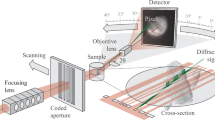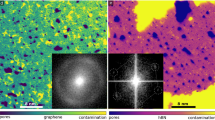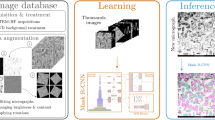Abstract
The important role of electron microscopy in the study of amorphous materials is in the examination of the local variation in structure, whether inherent or caused by deformation, irradiation or the nucleation of crystallisation. This requires that the image contain information about local spacings and their variability at the atomic level even if only in relation to a projection. Until recently commercial instruments could not do this for spacings less than about 0.3 nm, and material scientists have either concentrated on the interpretation of coarser structural irregularities in amorphous alloys or used indirect methods to get round the lack of resolving power of the objective lens of their microscopes (see ref. 1 for review). The interpretative dangers of the most obvious approach of using tilted illumination conditions are now well understood2–5. While the prospects for dark field interference techniques are a little more promising6 the essential problem of a nonlinear transfer function remains7. More interesting, though with other limitations, is the use of hollow cone illumination8 with axial transfer8–11. Here we present high resolution, axial illumination electron micrographs of such materials with detail at spacings less than 0.2 nm and discuss the difficulties involved in the interpretation of such images.
This is a preview of subscription content, access via your institution
Access options
Subscribe to this journal
Receive 51 print issues and online access
$199.00 per year
only $3.90 per issue
Buy this article
- Purchase on SpringerLink
- Instant access to full article PDF
Prices may be subject to local taxes which are calculated during checkout
Similar content being viewed by others
References
Howie, A. J. Non-Crystalline Solids 31, 41–55 (1978).
Howie, A., Krivanek, O. L. & Rudee, M. L. Phil. Mag. 27, 235–255 (1973).
Herd, S. R. & Chaudhari, P. Phys. Stat. Sol. A 26, 627–642 (1974).
McFarlane, S. C. & Cochran, W. J. Phys. C8, 1311–1321 (1975).
Ast, D. G., Krakow, W. & Goldfarb, W. Phil. Mag. 33, 985–1014 (1976).
Stobbs, W. M. The Structure of Non-Crystalline Materials (ed. Gaskell, P. H.) 253–256 (Taylor and Francis, London, 1977).
Saxton, W. O. J. Microsc. (in the press).
Scherzer, O. Optik 38, 387–405 (1973).
Krakow, W. Proc. 35th EMSA Meeting, 72–73 (Claitor's Publishing, Baton Rouge, 1977).
Saxton, W. O., Jenkins, W. K., Freeman, L. A. & Smith, D. J. Optik 49, 505–510 (1978).
Saxton, W. O. & Smith, D. J. in Developments in Electron Microscopy and Analysis 1979 (ed. Mulvey, T.) (in the press).
Saxton, W. O., Howie, A., Mistry, A. & Pitt, A. in Developments in Electron Microscopy and Analysis 1977 (ed. Misell, D. L.) 119–122 (1977).
Fields, P. & Cowley, J. M. Acta Crystallogr. A34, 103–112 (1978).
Stobbs, W. M. & Portier, R. Nature 281, 52–54 (1979).
Author information
Authors and Affiliations
Rights and permissions
About this article
Cite this article
Stobbs, W., Smith, D. High resolution imaging of amorphous materials. Nature 281, 54–55 (1979). https://doi.org/10.1038/281054a0
Received:
Accepted:
Published:
Issue date:
DOI: https://doi.org/10.1038/281054a0



